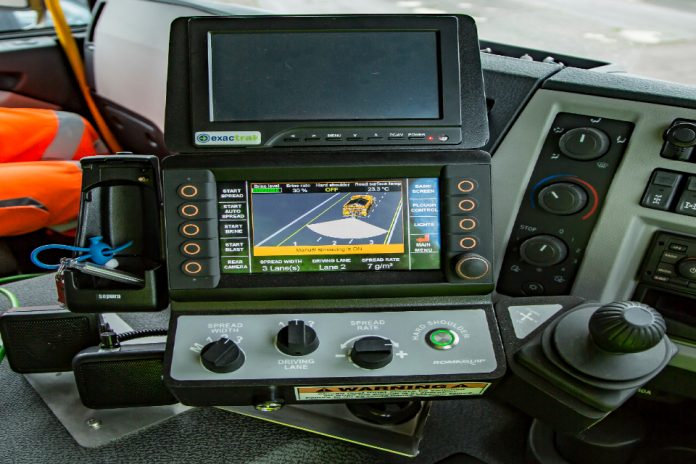The new gritters will improve safety for drivers and workers due to the vehicles’ improved technology, set up and enhanced visibility. They also treat the roads at a maximum of 50mph, 10mph faster than earlier models.
Highways England’s winter fleet manager Jane Wilkins said:
The latest vehicles contain innovative technology which includes being able to pre-programme the gritters with information specific to each gritting route. This enables salt to be spread onto the road automatically, considering any specific requirements for bridges, landscape and other road features allowing drivers to give their full attention to driving at all times.
When the wintry weather does arrive our 1,300 specially trained gritter drivers will be ready to work around the clock to keep traffic moving.
New state of the art Highways England gritter
To help keep drivers on the move this winter, Highways England has 535 gritters available which have all gone through a summer service, 127 depots based at strategic points across the network, 23 snow blowers which can remove up to 2,500 tonnes of snow per hour and will be storing over 280,000 tonnes of salt.
To monitor the weather around the clock Highways England has around 250 weather stations located across its 4,400 miles of motorways and major A roads. Overhead warning signs can also be used to inform motorists of severe weather.
When severe weather is forecast drivers should follow this advice:
- in snow and ice, drivers should stick to the main roads where they can and only travel if necessary – drivers are also encouraged to make sure they have a snow kit in their vehicle, including an ice scraper and de-icer, warm clothes and blankets and sunglasses to cope with the low winter sun.
- in high winds, there’s a particular risk to lorries, caravans and motorbikes, so drivers should slow down and avoid using exposed sections of road if possible.
- in heavy rain, drivers should keep well back from the vehicle in front, gradually ease off the accelerator if the steering becomes unresponsive, and slow down if the rain and spray from vehicles makes it difficult to see and be seen.
- in fog, drivers should switch on their fog lights and not use lights on full beam as the fog will reflect the light back. If you really cannot see, you should consider finding a safe place to stop until it is safe to continue.
Drivers are advised to follow messages on the overhead signs and listen to radio updates.
Further information can be found by visiting the Highways England Travel updates page, and by following @highwaysnwest @highwaysneast @highwaysseast @highwaysswest @highwayseast @highwayswmids, @highwaysemids @highwaysyorks on Twitter or calling the Highways England Information Line on 0300 123 5000.
General enquiries
Members of the public should contact the Highways England customer contact centre on 0300 123 5000.
Media enquiries
Journalists should contact the Highways England press office on 0844 693 1448 and use the menu to speak to the most appropriate press officer.







